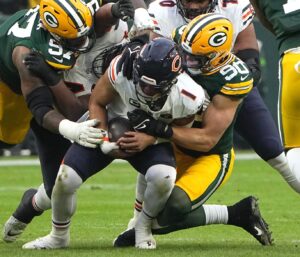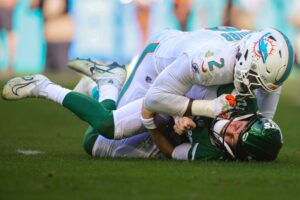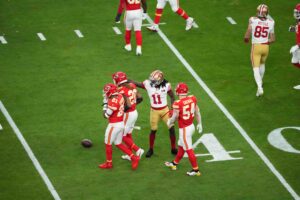On October 3, 1920, the Dayton Triangles defeated the Columbus Panhandles 14-0 and kicked off what is known today as the NFL. There were only 14 teams in the league during the inaugural season with the Akron Pros being awarded the championship. The Decatur Staleys and the Chicago Cardinals are the only two teams from the original 14 that are still around today but are now known as the Chicago Bears and Arizona Cardinals. Over the course of 100 years, the one constant has always been change. There have been new teams, new rules, new mascots, new logos, new leagues, new divisions, new championships, new this, new that, and it all comes together to what the NFL is right now.
NFL Divisions: The Need for Realignment
The NFL has done a great job of identifying and executing change over the years. They missed an opportunity for a change 17 years ago and the time to fix it is now. In 2002, the league added the Houston Texans as an expansion team giving the NFL 32 teams. With an even amount of teams, the NFL wisely elected to split both the AFC and NFC conferences into four equal divisions which were appropriately labeled North, East, South, and West. With geography as the base, the NFC North, AFC West, and NFC West have been exactly what the NFL wanted. A closer proximity for divisional rivalries, traveling fans, prideful fans, and all teams having success are just a few examples of what makes those three divisions so successful.
The NFL was wrong with the placement of teams in the other 5 divisions. They were only off by a single team in each division but the mistake has been detrimental. The extra miles needed for these mistakes is enough to drive around the Earth twice! Without moving any teams from the NFC to the AFC or vice-versa, 5,227 miles will be saved each season. The reduced miles will create new rivalries and a larger, more passionate fan base in each region. Here is what the new divisions would look like.
AFC East
The new AFC East will be comprised of the New England Patriots, Buffalo Bills, New York Jets, and Baltimore Ravens. According to Distance Between Cities, by removing the Miami Dolphins in favor of the Ravens, the AFC East will save 3,211 driving miles. The teams from the upper North-East corner of the United States will no longer need to take the trip to Miami every year. In addition, the competitive balance created will make the division a lot more interesting. As it stands now, the Patriots have rarely been challenged and the Ravens would be an instant rival for them. Sure, the Dolphins, Jets, and Bills have all had a good year here and there but that is all it has been; a single good year. This transformation brings a lot of excitement and attention to the AFC East for years to come.
AFC North
In order to send the Baltimore Ravens to the AFC East, the AFC North will be adding the Indianapolis Colts. The Colts will join the Cincinnati Bengals, Cleveland Browns, and Pittsburgh Steelers in a division that will be separated by the least amount of miles. The longest drive for any divisional game is a six-hour trip between Pittsburgh and Indianapolis across Interstate 70. The Steelers will lose their Baltimore rivals but the competitive addition of the Colts should make up for it. The history they have against each other and playing twice a year will create a new rivalry. The Bengals and their fans will benefit the most from this change. Their fans will save 425 miles by driving to Indianapolis compared to Baltimore, and the Ohio/Indiana rivalry will increase team pride. As a whole, this division will save 357 driving miles and will provide plenty of entertainment.
AFC South
This leaves the Miami Dolphins joining up with the Houston Texans, Tennessee Titans, and new in-state rival Jacksonville Jaguars. Of the three AFC divisional changes, the South division is the only one that adds mileage to their divisional travel. For the cost of 260 driving miles, the AFC South will now have an in-state rivalry between the Dolphins and Jaguars. Furthermore, every team in this division will be located in the southern half of the United States. Houston and Tennessee can maintain their franchise rivalry and Miami gets to save a lot of miles. Even with the extra miles needed for this division, fans and teams should be satisfied.
NFC South
With two divisions already properly set up, there isn’t a lot to shake up on the NFC side. However, by swapping the Dallas Cowboys for the Carolina Panthers, the NFC conference will save 1,919 driving miles. The new NFC South will consist of the New Orleans Saints, Tampa Bay Buccaneers, Atlanta Falcons, and Cowboys. The Cowboys will experience the most change as they will no longer need to make the trip to the upper East Coast. In addition, they will now have some pretty heated rivalries with their neighbors in New Orleans. With three teams in this division all having domes, this will be one of the loudest divisions in football.
NFC East
The final shakeup to the divisions is the aforementioned addition of the Panthers in place of the Cowboys. This change solidifies the name of the NFC East by having all four teams on the East Coast. Additionally, it saves the division 2,770 miles of driving to attend all of the games. The Giants, Eagles, and Redskins will maintain their rivalries with each other while the Panthers can build their rivalry with the Redskins. Another plus to this move is all four teams have outdoor stadiums. With each divisional game being outside, each game will present its own challenges.
As mentioned before, the NFL has never had a problem with making changes but this is one that needs to happen as soon as next year. There is never a peak if a business, team, or person is able to continuously improve. For the NFL, this is just an additional upward step on their fabulous journey.






